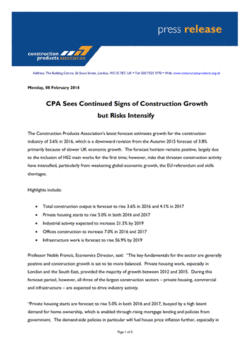 The Construction Products Association’s latest forecast estimates growth for the construction industry of 3.6% in 2016, which is a downward revision from the Autumn 2015 forecast of 3.8% primarily because of slower UK economic growth. The forecast horizon remains positive, largely due to the inclusion of HS2 main works for the first time; however, risks that threaten construction activity have intensified, particularly from weakening global economic growth, the EU referendum and skills shortages. Highlights include:
The Construction Products Association’s latest forecast estimates growth for the construction industry of 3.6% in 2016, which is a downward revision from the Autumn 2015 forecast of 3.8% primarily because of slower UK economic growth. The forecast horizon remains positive, largely due to the inclusion of HS2 main works for the first time; however, risks that threaten construction activity have intensified, particularly from weakening global economic growth, the EU referendum and skills shortages. Highlights include:
- Total construction output is forecast to rise 3.6% in 2016 and 4.1% in 2017
- Private housing starts to rise 5.0% in both 2016 and 2017
- Industrial activity expected to increase 21.3% by 2019
- Offices construction to increase 7.0% in 2016 and 2017
- Infrastructure work is forecast to rise 56.9% by 2019
Professor Noble Francis, Economics Director, said: “The key fundamentals for the sector are generally positive and construction growth is set to be more balanced. Private housing work, especially in London and the South East, provided the majority of growth between 2012 and 2015. During this forecast period, however, all three of the largest construction sectors – private housing, commercial and infrastructure – are expected to drive industry activity.
“Private housing starts are forecast to rise 5.0% in both 2016 and 2017, buoyed by a high latent demand for home ownership, which is enabled through rising mortgage lending and policies from government. The demand-side policies in particular will fuel house price inflation further, especially in the capital, whilst also incentivising major house builders to increase building rates over the next 12-18 months. In addition, given all the government assistance to boost the housing market, house builders are likely to be under pressure to increase supply throughout parliament.
“Public housing prospects continue to be poor. Housing associations will be adversely affected by a lack of funding as rental income will be hit by the extension of Right to Buy and cuts to social rent. Public housing starts are expected to fall a further 5.0% in 2016 and no significant growth is expected over the forecast period.
Professor Francis continued: “The commercial sector is forecast to improve 3.7% on average per year through to 2019. New offices construction will lead activity in the sector, increasing 7.0% in 2016 and 2017, due to a flurry of high profile developments in London, Birmingham and Manchester. Retail construction, on the other hand, is expected to remain flat in 2016 and only rise 2.0% in 2017.
“The infrastructure sector is set to stand out, rising 56.9% by 2019 owing to substantial activity in the rail, energy, roads, water and sewerage sub-sectors. Major projects across the sector will add to generally improving work levels. Rail work will primarily be driven by Network Rail activity but also boosted by HS2, which the CPA has now included in its forecasts. In previous forecasts, uncertainty regarding its cost, planning and timing caused it to be excluded.
“The energy sub-sector will be boosted by work on Hinkley Point C where main works are anticipated from 2018, though further delays cannot be ruled out. Roads construction is also likely to increase throughout the forecast period, by 37.2%, but this is substantially less than was initially expected as Highways England struggles to enact its project pipeline to time and budget.
“There are significant risks to this forecast, however. First is the uncertainty regarding global economic prospects. The chief concern remains weakness in China and the effect it can have on other countries. Second is the EU Referendum, likely due this year. While we make no assumption about the result, we note the uncertainty around the issue is already affecting investment decisions. Third and perhaps of most importance for the industry is the urgent challenge around skills shortages. The availability and cost of skilled labour has clearly impacted the house building sector; the recovery in other sectors is already showing a similar vulnerability.”
ENDS
NOTE TO EDITORS:
The Construction Products Association represents the UK’s manufacturers and distributors of construction products and materials. The sector directly provides jobs for 313,000 people across 21,000 companies and has an annual turnover of more than £50 billion. The Association acts as the leading voice to promote and campaign for this vital UK industry.
The State of Trade Survey is one of a range of economic publications produced regularly by the Association, including the Construction Trade Survey and the Construction Industry Forecasts.
FOR FURTHER INFORMATION CONTACT:
Rebecca Larkin
Senior Economist
Construction Products Association
Tel: 020 7323 3770
E-mail: rebecca.larkin@constructionproducts.org.uk
Jeff May
Marketing and Communications Manager
Construction Products Association
Tel: 07904 476 166
E-mail: jeff.may@constructionproducts.org.uk
Follow the Construction Products Association on Twitter: https://twitter.com/CPA_Tweets
